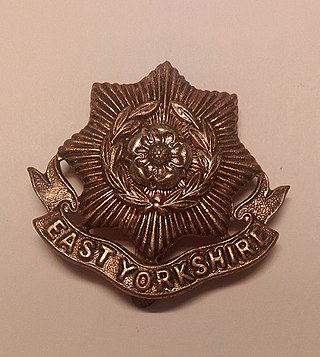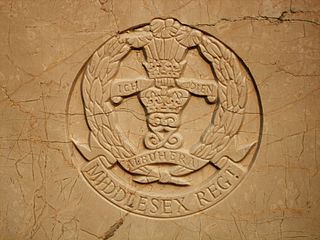The 102nd Brigade was an infantry formation of the British Army during World War I. It was raised as part of 'Kitchener's Army' and assigned to the 34th Division. After the original formation was converted into a reserve brigade, the number was transferred to a brigade of 'Tyneside Scottish', four 'Pals battalions' of the Northumberland Fusiliers recruited from men of (mainly) Scottish birth or heritage working on Tyneside. The brigade landed in France at the end of 1915 and then served on the Western Front for the rest of the war. The brigade suffered appalling casualties on the First day of the Battle of the Somme. It recovered to participate in the Battle of Arras in 1917, but was virtually destroyed during the German spring offensive of 1918. It was reconstituted with different units in time to take part in the final battles of the war and the post-war occupation of the Rhineland.
The Public Schools Battalions were a group of Pals battalions of the British Army during World War I. They were raised in 1914 as part of Kitchener's Army and were originally recruited exclusively from former public schoolboys. When the battalions were taken over by the British Army they became variously the 16th (Service) Battalion of the Middlesex Regiment and the 18th–21st (Service) Battalions of the Royal Fusiliers. However, Kitchener's Army was faced with a dire shortage of officers and so 'young gentlemen'— public schoolboys and university graduates, including many of those who had enlisted in the Public Schools Battalions — were encouraged to apply for commissions. The battalions' depleted ranks were made up with ordinary volunteers and although they retained the Public Schools titles, their exclusive nature was doomed. Two battalions remained to serve on the Western Front: the original battalion was all but destroyed on the first day of the Somme. After hard service both battalions were disbanded in February 1918 before the end of the war.

The Northumbrian Division was an infantry division of the British Army, formed in 1908 as part of the Territorial Force with units drawn from the north-east of England, notably Northumberland, Durham and the North and East Ridings of Yorkshire. The division was numbered as 50th (Northumbrian) Division in 1915 and served on the Western Front throughout the First World War. Due to losses suffered in the Ludendorf Offensive in March 1918 it had to be comprehensively reorganized. It was once again reformed in the Territorial Army as the Northumbrian Division in 1920.

The Sheffield City Battalion was a 'Pals battalion' formed as part of 'Kitchener's Army' during World War I. Raised by local initiative in the City of Sheffield, it became the 12th (Service) Battalion of the local York and Lancaster Regiment. After almost two years of training, it was virtually destroyed on the first day of the Battle of the Somme in a disastrous attack on the village of Serre. The battalion continued to serve on the Western Front, including the Arras offensive, but it was disbanded early in 1918.

The Barnsley Pals were two 'Pals battalions' formed as part of 'Kitchener's Army' during World War I. Raised by local initiative in the town of Barnsley in the West Riding of Yorkshire and recruited largely from coalminers, they became the 13th and 14th (Service) Battalions of the local York and Lancaster Regiment. After almost two years of training, the battalions suffered heavy casualties in a disastrous attack on the village of Serre on the first day of the Battle of the Somme. They continued to serve on the Western Front, including the Battle of Arras (1917). Combined into a single battalion in early in 1918, the Barnsley Pals were reduced to a remnant during the German spring offensive, but the battalion was rebuilt to participate in the final victorious Hundred Days Offensive.
The 93rd Brigade was an infantry formation of the British Army during World War I. It was raised as part of 'Kitchener's Army' and was assigned to the 31st Division. After the original formation was converted into a reserve brigade, the number was transferred to a brigade of 'Pals battalions' from Northern England. The brigade was sent to Egypt at the end of 1915 but was recalled to France shortly afterwards and then served on the Western Front for the rest of the war. The brigade was shattered on the First day on the Somme, but later saw action at Arras, in the German spring offensive of 1918, and the final Hundred Days Offensive.

98th Brigade was an infantry formation of the British Army created to command 'Kitchener's Army' units during World War I. It served on the Western Front from 1916, seeing action on the Somme, at Arras and Ypres, during the German spring offensive and the final Allied Hundred Days Offensive.
The 110th Brigade was an infantry formation of the British Army during World War I. It was raised as part of 'Kitchener's Army' and was assigned to the 37th Division. After the original formations were renumbered, the numbers were transferred to a new brigade and division formed from unallocated 'Army Troops'. The new 110th Brigade was formed from the Kitchener battalions of the Leicestershire Regiment, known as 'The Tigers' from its regimental badge: consequently the brigade was also known by this nickname. The brigade went to the Western Front with 37th Division, but shortly after the start of the Battle of the Somme it was transferred to the 21st Division and fought with that formation for the rest of the war, distinguishing itself in its first offensive action, the Battle of Bazentin Ridge and later at the Capture of Gueudecourt. It also fought at Arras, Ypres, against the German spring offensives when it was virtually destroyed, and in the final victorious Hundred Days Offensive.
The Sunderland Rifles was a Volunteer unit of the British Army formed in 1860. It went on to become a Battalion of the Durham Light Infantry (DLI) in the Territorial Force and saw action as infantry and pioneers in some of the bloodiest actions on the Western Front during World War I. Between the wars it became an air defence unit, serving during World War II in The Blitz and the campaign in North West Europe, when it had a special role in the Rhine crossing. Postwar it continued in the Territorial Army in the air defence role until 1975, when its successor unit reverted to infantry.
The Bradford Rifles was a Volunteer unit of the British Army formed in 1859. It went on to become a battalion of the West Yorkshire Regiment in the Territorial Force and saw action on the Western Front during World War I. Between the wars it converted into an air defence unit, serving during World War II first as a searchlight regiment defending West Yorkshire and later as a garrison battalion in North West Europe. Postwar it continued in the Territorial Army in the air defence role until 1955.

The Hull Pals were a brigade of four battalions of the East Yorkshire Regiment raised as part of Kitchener's Army in 1914. They served in 31st Division at Serre on the first day of the Battle of the Somme in 1916, though they escaped the worst of the disaster. However, they suffered heavy casualties in the same area later in the year, and again at Oppy Wood in early 1917. They continued to serve on the Western Front for the rest of the war, including hard fighting against the German spring offensive and in the final Hundred Days Offensive.

The 1st Battalion, London Regiment was a volunteer unit of the British Army under various titles from its foundation in 1859 in Bloomsbury, London, by the author of Tom Brown's Schooldays. It served in Malta, Gallipoli, Egypt and on the Western Front during World War I. In World War II it served in Iraq, North Africa and Italy. It amalgamated with other Territorial units of the Royal Fusiliers in the 1960s.
The 2nd Battalion, London Regiment was a volunteer infantry battalion of the British Army under various titles from 1860 to 1961. It served in Malta, Gallipoli, Egypt and on the Western Front during World War I. In World War II it saw service in Iraq, North Africa and Italy. After a postwar spell as an air defence unit, it reverted to the infantry role, and merged into the Territorials of the Royal Fusiliers.

The 10th Battalion, Middlesex Regiment, was an infantry unit of Britain's Territorial Force from 1908 to 1920. Based in Ravenscourt Park, West London, its part-time soldiers saw service at Gallipoli, in Palestine, and on the Western Front during the First World War. After the war the battalion was amalgamated into a unit of the new Royal Corps of Signals.

The Hull Rifles, later the 4th Battalion, East Yorkshire Regiment, was a unit of Britain's Volunteer Force first raised in Kingston upon Hull in 1859. During the First World War it served on the Western front, seeing a great deal of action at Ypres, the Somme, Arras, and in the German spring offensive, when it was virtually destroyed. Its 2nd Line battalion garrisoned Bermuda for much of the war. During the Second World War the 4th Battalion was captured at the Battle of Gazala, but its wartime duplicate unit fought on through the Western Desert, Tunisia and Sicily, and then landed in Normandy on D Day. The battalion served in the postwar Territorial Army until 1960, and its successors in today's Army Reserve continue in Hull.
The 12th (Service) Battalion, Manchester Regiment, was a unit of 'Kitchener's Army' formed immediately after the outbreak of the First World War. It saw action in the Ypres Salient in 1915–16, on the Somme in 1916, including actions at Mametz Wood and the Battle of Delville Wood, and in the Arras Offensive. It was then amalgamated with the dismounted cavalry of the Manchester-based Duke of Lancaster's Own Yeomanry (DLOY) to become the 12th (DLOY) Battalion, Manchester Regiment. It continued serving on the Western Front until the Armistice with Germany, including the Battle of Passchendaele, the German Spring Offensive and the final Allied Hundred Days Offensive.

The 22nd (Service) Battalion, Royal Fusiliers (Kensington) was a 'Pals battalion' raised in London for 'Kitchener's Army' in World War I. Half of the volunteers came from the Royal Borough of Kensington, the other half were 'Colonials' from around the British Empire. This unusual battalion served on the Western Front from November 1915 until its disbandment in February 1918, seeing action at the Somme, the Ancre, Arras and Cambrai.

The 13th (Service) Battalion, Royal Fusiliers, was an infantry unit recruited as part of 'Kitchener's Army' in World War I. It served on the Western Front from July 1915 until the Armistice, seeing action at the Somme and the Ancre, at Arras and Ypres, against the German spring offensive, and in the final Hundred Days Offensive.

The 17th (Service) Battalion, Royal Fusiliers (Empire), was a 'Pals battalion' recruited as part of 'Kitchener's Army' in World War I. It served with the 2nd Division on the Western Front from November 1915 until the Armistice, seeing action on the Somme and the Ancre, at Arras and Cambrai, against the German spring offensive, and in the final Hundred Days Offensive, when it made a daring crossing of the St Quentin Canal.

The 17th (Service) Battalion, King's Royal Rifle Corps, was an infantry unit recruited by the British Empire League as part of 'Kitchener's Army' in World War I. It served on the Western Front, including the battles of the Somme and the Ancre, the Third Battle of Ypres and the German spring offensives. After its losses the battalion was reduced to a training cadre for the rest of the war, helping to prepare newly arrived US troops and others for Trench warfare. It was disbanded in 1919.


















